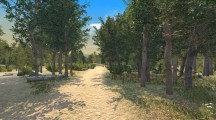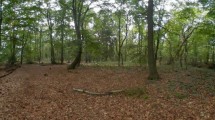Abstract
Many studies have suggested that natural landscapes could relieve stressful sentiments regardless of how the virtual nature is presented. Thus, we investigated the effect of a virtual working environment on workers’ mental and physiological states using psychophysiological measures and subjective assessments. Twenty-two healthy male students (22.0 ± 0.9 yrs.) voluntary participated in the study. The results indicated that the finger plethysmogram (PTG) amplitude measured in a forest environment was significantly lower than that measured in an office environment. However, the differences in subjective fatigue and stress between the two environments were negligible. Therefore, we assumed that the forest environment could enhance sympathetic activity owing to an excited-pleasurable working experience. However, other more sophisticated measures should be introduced. Furthermore, it is necessary to investigate the subtle effects of nature using more sensitive methods.
Access this chapter
Tax calculation will be finalised at checkout
Purchases are for personal use only
Similar content being viewed by others
References
Monika, F., Pawel, W.: Literature survey on how different factors influence human comfort in indoor environments. Build. Environ. 46(4), 922–937 (2011)
Nis, H., Dag, R., Anne, K.B., Nils, F., Ulf, L., Karen, S.: The effect of mental stress on heart rate variability and blood pressure during computer work. Eur. J. Appl. Physiol. 92, 84–89 (2004)
Roger, S.U., Robert, F.S., Barbara, D.L., Evelyn, F., Mark, A.M., Michael, Z.: Stress recovery during exposure to natural and urban environments. J. Environ. Psychol. 11, 201–230 (1991)
Yeo, N.L., et al.: What is the best way of delivering virtual nature for improving mood? An experimental comparison of high-definition TV, 360◦ video, and computer generated virtual reality. J. Environ. 72, 101500 (2020)
https://files.eric.ed.gov/fulltext/EJ1131318.pdf. Accessed 23 May 2022
Stefan, L., Linda, G., Maic, M.: The relaxing effect of virtual nature - immersive technology provides relief in acute stress situations. Ann. Rev. Cyber Ther. Telemed. 16, 87–93 (2018)
Gao, T., Zhang, T., Zhu, L., Gao, Y., Qiu, L.: Exploring psychophysiological restoration and individual preference in the different environments based on virtual reality. Int. J. Environ. Res. Public Health 16, 3102 (2019)
Chia-Pin, Y., Hsiao-Yun, L., Xiang-Yi, L.: The effect of virtual reality forest and urban environments on physiological and psychological responses. Urban For. Urban Green. 35, 106–114 (2018)
Matilda, A., et al.: Inducing physiological stress recovery with sounds of nature in a virtual reality forest—results from a pilot study. Physiol. Behav. 118, 240–250 (2013)
Maryam, M., Yimin, Z.: Application of virtual environments for biophilic design: a critical review. Building 11(4), 148 (2021)
Jie, Y., Jing, Y., Nastaran, A., Paul, J.C., Joseph, G.A., John, D.S.: Effects of biophilic in-door environment on stress and anxiety recovery: a between-subjects experiment in virtual reality. Environ. Int. 136, 105427 (2020)
Inoue, A., Kawakami, N., Shimomitsu, T., Tsutsumi, A., Haratani, T., Yoshikawa, T., et al.: Development of a short version of the new brief job stress questionnaire. Ind. Health 2014(52), 535–540 (2014)
Tsutsumi, A., Inoue, A., Eguchi, H.: How accurately does the Brief Job Stress Questionnaire identify workers with or without potential psychological distress? J. Occup. Health 2017(59), 356–360 (2017)
Author information
Authors and Affiliations
Corresponding author
Editor information
Editors and Affiliations
Rights and permissions
Copyright information
© 2022 The Author(s), under exclusive license to Springer Nature Switzerland AG
About this paper
Cite this paper
Kikuchi, S., Konishi, R., Goda, R., Kan’no, Y., Miyake, S., Kobayashi, D. (2022). Evaluation of a Virtual Working Environment via Psychophysiological Indices. In: Kurosu, M., et al. HCI International 2022 - Late Breaking Papers. Design, User Experience and Interaction. HCII 2022. Lecture Notes in Computer Science, vol 13516. Springer, Cham. https://doi.org/10.1007/978-3-031-17615-9_18
Download citation
DOI: https://doi.org/10.1007/978-3-031-17615-9_18
Published:
Publisher Name: Springer, Cham
Print ISBN: 978-3-031-17614-2
Online ISBN: 978-3-031-17615-9
eBook Packages: Computer ScienceComputer Science (R0)




